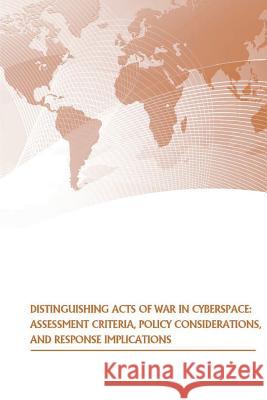Distinguishing Acts of War in Cyberspace: Assessment Criteria, Policy Considerations, and Response Implications » książka
Distinguishing Acts of War in Cyberspace: Assessment Criteria, Policy Considerations, and Response Implications
ISBN-13: 9781505585490 / Angielski / Miękka / 2014 / 116 str.
Distinguishing Acts of War in Cyberspace: Assessment Criteria, Policy Considerations, and Response Implications
ISBN-13: 9781505585490 / Angielski / Miękka / 2014 / 116 str.
(netto: 76,25 VAT: 5%)
Najniższa cena z 30 dni: 79,40
ok. 16-18 dni roboczych.
Darmowa dostawa!
This book is comprised of four main sections: Characterization. This section provides the notional foundation necessary to avoid any devolution of the analysis to mere semantic arguments.It presents how cyberspace is defined and characterized for this discussion, as well as how this compares to existing concepts of the traditional domains of land, sea, air, and space. Also, it identifies some of the unique technical challenges that the cyberspace domain may introduce into the process of distinguishing acts of war. Assessment Criteria. This section explores the dejure and the defacto issues involved with assaying cyber incidents to determine if they represent aggression and possible use of force; and, if so, to what degree? It reviews the traditional legal frameworks surrounding military action to include the United Nations (UN) Charter and the Law of Armed Conflict. It also examines how these compare to the recently published Tallinn Manual on the International Law Applicable to Cyber Warfare. From these sources, it proposes a cyberspace incident assessment methodology. Policy Considerations. Having identified viable criteria to aid with the assessment of cyber-space incidents, this section looks at the policy considerations associated with applying such principles. First, it examines the relevant U.S. strategies; next, it investigates the strategies of other key countries and international organizations and how they compare to U.S. tenets; and finally, it evaluates how non state actors may affect U.S. deliberations. Courses of Action. This section examines the influences that course of action development and implementation may have on the assessment of cyberspace incidents. It first looks at the President's role as the primary decision maker in U.S. national matters regarding cyber-space. It then surveys key influences affecting subordinate decision makers and their staffs that may be advising the Commander-in-Chief: reliable situational awareness, global and domestic environment considerations, and options and their related risks and potential consequences. Any reader expecting a perfect solution for this conundrum will be disappointed, as the examination is more about the journey than the destination. In the end, many of the challenges with this issue are common with those of the traditional domains; however, the complex and dynamic character of the cyberspace domain introduces unique vexations for senior policymakers and decision makers. The conclusion of this book includes recommendations that the author hopes will aid in the positive evolution toward a better understanding and mitigation of the fog and friction surrounding the distinction of acts of war in cyberspace."
Zawartość książki może nie spełniać oczekiwań – reklamacje nie obejmują treści, która mogła nie być redakcyjnie ani merytorycznie opracowana.











